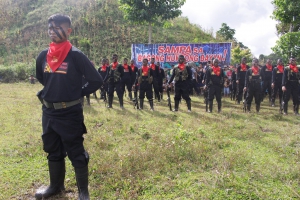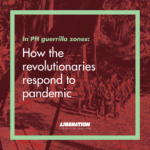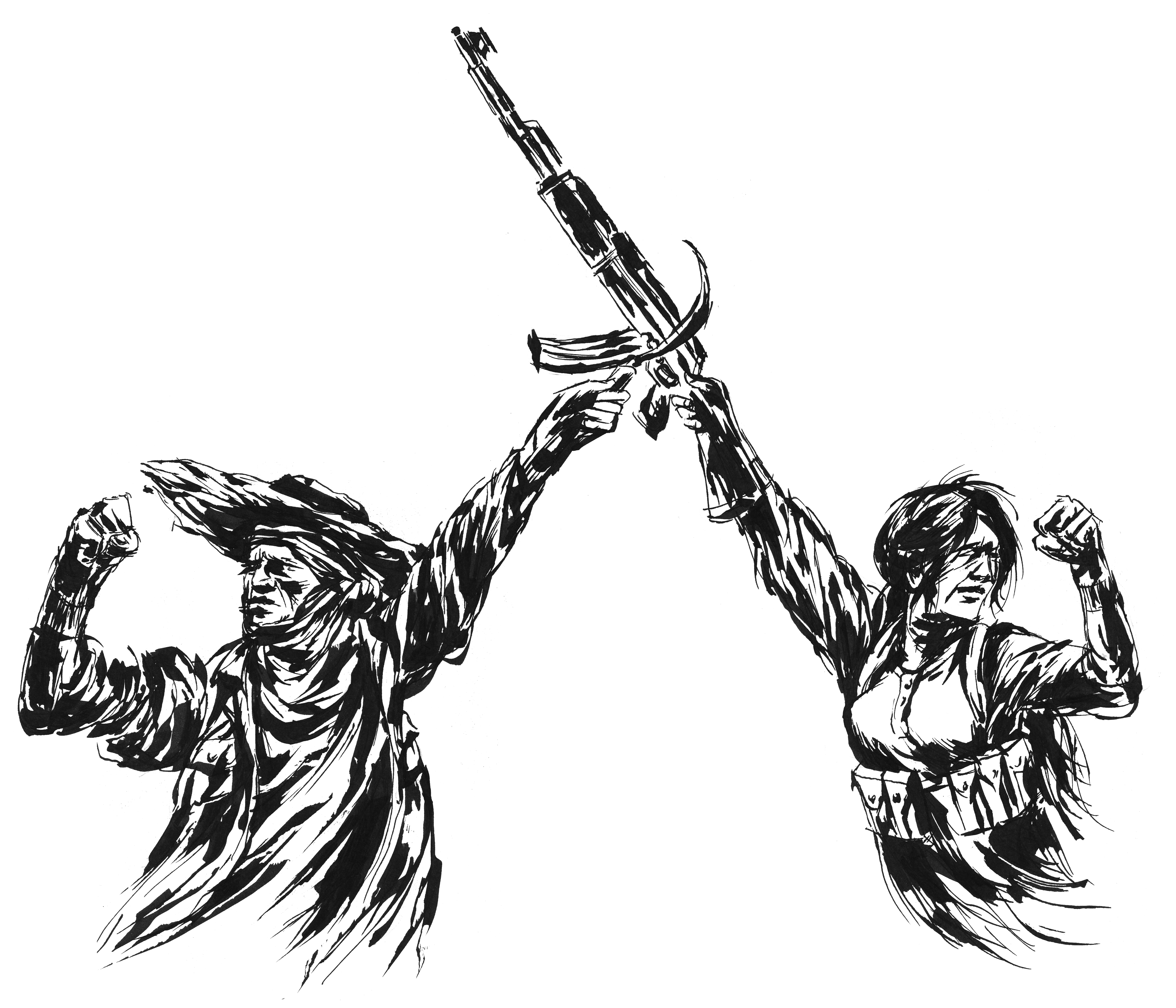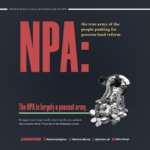CPP’s 48th Anniversary: The Masses’ Revolutionary Power at Work

by Iliya Makalpay
Brgy. Lumiad, Paquibato District, Davao City— “Naa pa si Tatay, o! (Look, Father is still there!),” A child on board a passenger bus called out in Cebuano. “Tatay” was the slain New People’s Army (NPA) commander Leoncio “Ka Parago” Pitao, who was killed in a special military operation by the AFP on June 28, 2015 in one of the villages in Paquibato District where he was undergoing treatment by a woman NPA medic who was also killed.
It had been three days after the 48th anniversary celebration of the Communist Party of the Philippines (CPP) on December 26, but Ka Parago’s standee remained atop a makeshift platform near the gymnasium. The huge photo was among the features of the celebration before which villagers and visitors, young and old, had their pictures taken. A giant hammer and sickle lantern was still mounted behind the standee. The huge lantern was lit up along with 48 sky lanterns to cap the December 26 event.
At the sight of Ka Parago’s standee, the bus passengers were transported back to the anniversary celebration and the weeks leading to it. Three days after the event, the stories told around sounded as fresh as they had been the morning after—where people on street corners, in sari-sari stores, at the front yard of houses huddled and shared anecdotes and laughter. They bantered at how they had to walk sideways to navigate through the huge crowd at the gathering. They laughed at how they panicked over preparing and distributing food to the crowd . They marvelled about the program and how their sons and daughters fared in the cultural numbers. They laughed at each other’s gaffes in performing their assigned tasks.
. They marvelled about the program and how their sons and daughters fared in the cultural numbers. They laughed at each other’s gaffes in performing their assigned tasks.
But all their faces beamed with pride.
The NPA members who marched in battalion-size formation during the anniversary celebration earned the public’s awe. The crowd—the almost 20,000 masses who came on foot, and in buses, jeepneys, cars and on motorbikes from all over Mindanao, Visayas and Luzon—was equally remarkable. Everyone was in high spirits in that all-inspiring moment—a spectacle never seen before.
Revolutionary mass movement
Call it a show of force, yes. But, the other lesser-known force behind that spectacular show were the members of the Party units and various allied organizations of the National Democratic Front of the Philippines (NDFP) who worked enthusiastically with the NPA members to prepare for the event. They comprised the revolutionary organs of political power in the district.
“It’s a first in our barrios and we were so nervous. We never thought we could pull it off,” said Ka Deling, a member of MAKIBAKA or the Free Movement of New Women, a revolutionary women’s mass organization allied with the NDFP. The MAKIBAKA members were among the almost 4,000 revolutionary masses from different barrios mobilized to take on different tasks for the celebration.
Many of those mobilized were assigned in the food committee. Food preparation needed more people compared to other tasks as thousands of visitors expected to attend must be fed breakfast, lunch and supper. About 700 men were assigned to cook the rice, said Ka Deling. Other MAKIBAKA members were assigned in the kitchen and food distribution. Packed lunches were distributed through the team leaders of each delegation from the different regions of Mindanao and from Luzon and the Visayas. (At midday on December 26, more food packs and roasted pigs came in as gifts from city, provincial and even national government officials.) “Cooking involved several villages, and the cooks brought their own pots and pans and other cooking utensils. They also brought their own firewood,” said Ka Jose, a member of the Pambansang Katipunan ng mga Magbubukid (National Association of Farmers), a founding member of the NDFP.
Others members of the revolutionary organizations were assigned to take care of transportation, mobilizing at least 40 drivers for the borrowed buses and motorcycles. A temporary clinic was set up manned by the barrio’s health committee and NPA medics. Another group of men and women were assigned to help in the construction of the stage and in decorating the covered court where the program was held. They, too, brought their own tools. Houses in the barangay, and even the barangay hall, were opened to visitors who chose to spend the night in the barrio, especially those from Visayas and Luzon.
Local Kabataang Makabayan members and city-based artists who were members of or mobilized by ARMAS (Artists and Writers of the People), another NDFP allied organization, worked with the NPA-based director, production manager and choreographers to mount the six major production numbers and oversee the day-long program. There was a group assigned to liaison with the media.
 Two platoons of the Milisyang Bayan (MB, People’s Militia) beefed up the NPA security force to thwart any untoward action by the military during the celebration. Ka Deling recalled that four days before, members of the paramilitary group CAFGU put up a blockade on the road leading to the venue. But this was immediately dismantled by the people. On December 23, a group of policemen wanted to check whether the village is “drug-free”. But the people only jeered at the policemen. Warning that the NPA forces are around, the masses told the policemen they could enter the village only if they left their weapons behind.
Two platoons of the Milisyang Bayan (MB, People’s Militia) beefed up the NPA security force to thwart any untoward action by the military during the celebration. Ka Deling recalled that four days before, members of the paramilitary group CAFGU put up a blockade on the road leading to the venue. But this was immediately dismantled by the people. On December 23, a group of policemen wanted to check whether the village is “drug-free”. But the people only jeered at the policemen. Warning that the NPA forces are around, the masses told the policemen they could enter the village only if they left their weapons behind.
On the day of the celebration, no uniformed military or police was visible in the barrio. Instead, there were two NPA checkpoints installed on the main road leading to the venue “to ensure that only those invited could enter.”
The day after the event, the masses and a unit of the NPA cleaned up the whole village. In a matter of four hours, everything was back to its proper place—save for Ka Parago’s standee and the huge hammer-and-sickle lantern. “We did not expect the event would be this grand. But, kaya man diay (We made it), with the guidance of the comrades from the Party and the people’s army,” Ka Manding exultantly remarked.
Ka Tien, the political officer of the Pulang Bagani Battalion (PBB) and Ka Led, the event’s production manager, attributed the success of the celebration, specifically the masses’ active participation to the years of painstaking organizing and consolidation work in the district, initiated by the Party and the PBB led by Ka Parago. Both claimed they were “standing on Parago’s shoulders.”
Ka Jose, a long-time organizer in the district, acknowledged that he doubted for a moment the movement’s future after Ka Parago was slain. “But we realized there are many Ka Paragos in the Party and in the NPA. The years of hard work by comrades have paid off,” he said.
Soon after Ka Parago’s funeral march through Davao City to his final resting place, the masses and their revolutionary mass organizations were in fighting form again, mindful that many tasks lie ahead. “We have become more conscientious because we cannot fail our slain leader and the martyrs of the revolution,” Ka Jose stressed.
People’s war leads to JUST peace
The Davao City celebration was the center of the nationwide observance of the CPP 48th anniversary. CPP founding Chairperson and NDFP Chief Political Consultant Jose Maria Sison addressed the crowd through a video message. NDFP Negotiating Panel Senior Adviser Luis Jalandoni, panel member Coni Ledesma, NDFP peace consultants Concha Araneta, Porferio Tuna and Eduardo Genelsa, did not only lead the panel of program speakers, they also freely and happily mingled with the masses and the NPA fighters, indulging them with photo-op sessions.
Across the country, the deepening and widening strength and influence of the revolutionary movement was manifested in various guerrilla fronts. Tens of thousands of people and the NPA fighters raised the CPP flag and waved the banners of the NDFP and its allied revolutionary organization as a tribute to the Party’s leadership in the Philippine revolution.
While the masses voiced out their support for the peace negotiations, the 48th anniversary celebration was also an occasion for them to manifest their rage against the failed promises of the Duterte administration, specifically its failure to release all political prisoners through general amnesty. The masses had expressed their desire for the NPA to end  its unilateral ceasefire in the face of the escalating attacks by the Armed Forces of the Philippines (AFP) and the Philippine National Police (PNP) against them and their communities.
its unilateral ceasefire in the face of the escalating attacks by the Armed Forces of the Philippines (AFP) and the Philippine National Police (PNP) against them and their communities.
At bottom, the celebration of the 48th anniversary of the CPP was a pledge to continue to raise the people’s war to greater heights towards achieving genuine and lasting peace over the long haul, while building up revolutionary gains that benefit the people. Across the country, the slogan “people’s war is for people’s peace” reverberated.
Victory for the masses
Many take up and vigorously echo the call. The sound of the numerous voices of the masses is indeed contagious, inspiring and invigorating.
“Daghan man diay ta, dili lang diay kami ang nakigbisog, (I realized there are many of us. We are not alone in this struggle),” said one resident of Bgy. Lumiad. The visitors and the host communities drew inspiration from each other to push forward the people’s war and face down enemy threats.
“Pagkakita nako sa mga tao, kit-an gyud nako na mudaug gyud ang rebolusyon. (When I saw the crowd, I knew the revolution would be victorious. No doubt the masses will triumph),” he gushed.








